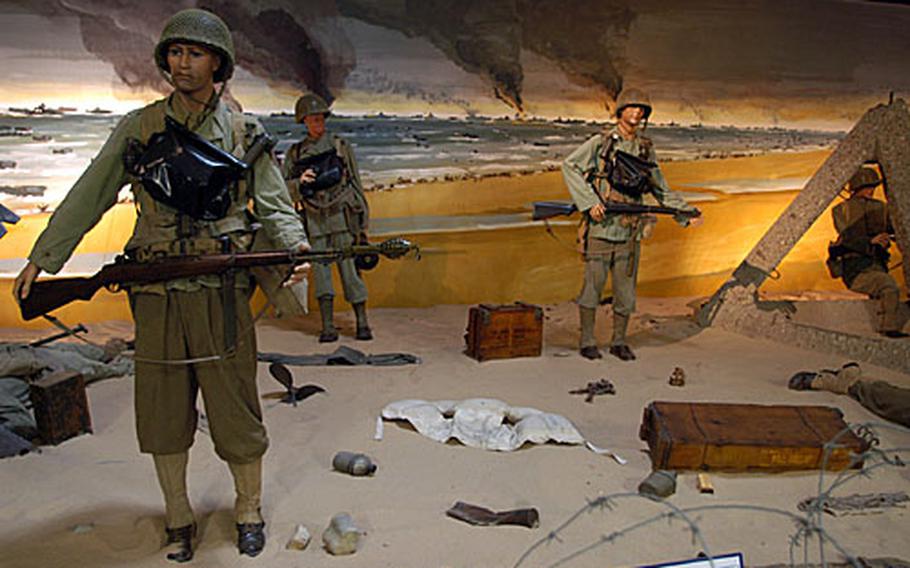
Exhibits at the Musée Memorial d' Omaha Beach cram World War II memorabilia into scenes as they try to re-create the American landing on D-Day. The museum, though not the biggest dedicated to the Normandy invasion, nevertheless has an impressive collection of both U.S.and German weapons, vehicles, clothing and equipment. (Matt Millham / S&S)
There are plenty of World War II battle sites and museums worth visiting in Normandy, but all have one overwhelming shortcoming: They don’t tell the whole story.
The Normandy American Cemetery’s new visitor center is no different, though it offers a good account of the American role in the D-Day invasion.
But in order to get a really good idea of what happened here, there are some sites that can’t be missed.
Pointe du Hoc, a free site and monument maintained by the American Battle Monuments Commission, offers some of the most dramatic evidence of the Allied invasion. Here, swimming-pool-sized bomb craters still pock this once-strategic overlook on the shore of the English Channel, and the remains of German fortified gun positions and bunkers, some smashed, some intact, lie quietly among verdant grass.
It was here that Lt. Col. James E. Rudder led 255 Army Rangers from the 2nd Ranger Battalion up the cliffs to destroy the German artillery that had threatened both Omaha and Utah beaches. But when Rudder and his men scaled the cliffs, they found the guns were already gone. They later discovered the Germans’ main 155 mm gun camouflaged south of the point, and destroyed it.
East of Pointe du Hoc, the seaside town of Arromanches is worth visiting for anyone interested in the ingenuity, work and material that went into making the landing a success.
Here, off Gold Beach, dozens of remnants of the British Mulberry Harbor used to offload equipment and personnel for the invasion still poke through the waters of the English Channel. The giant structures — 33 jetties made of 600,000 tons of concrete with 10 miles of floating roadways atop them — were designed and built for the sole purpose of unloading men and equipment during the invasion and floated there from England.
Though not much of the makeshift harbor remains, the Musée du Debarquement has room- sized models that show what the harbor looked like when it was complete and explain how it all came together.
There are other free sites east of Arromanches along Juno Beach, which the Canadians took, and Sword Beach, another British landing point.
One of those, about halfway between Sword Beach and the city of Caen, is the Hillman bunker complex. Out of range of navy guns that tried to soften the German defenses before the invasion, the German troops manning the bunkers were fresh and ready for the British attack. The British were able to take the complex in a hand-to-hand fight.
The Big Red One Assault Museum, on the D-514 just east of the American cemetery, holds the personal collection of Pierre-Louis Gosselin, who changes the exhibits at least once a year.
The small but popular museum focuses on the units that landed on Omaha Beach’s Fox Green, and Fox Red sectors, which includes elements of the 1st Infantry Division, engineers and Navy beach battalions.
To the west of the cemetery and within view of the English Channel, the Musee Memorial d’ Omaha Beach holds a large collection of German and American weapons, equipment, clothing and vehicles. Dioramas crammed with memorabilia line the walls, and pictures and placards tell the rest of the story.
Know & Go
For those interested in visiting Normandy’s museums, it’s worth the money to buy the Normandie Pass. If you purchase a full-price ticket at one museum, you can also buy a pass for 1 euro. From then on, if you show the pass every time you pay for admission at another museum, you will get a discount of up to 2 euros, depending on the museum. The pass is available at any of the participating museums. See www.normandiepass.com/ pages/index_uk.html or e-mail info@normandiememoire.com.
Following are opening times and prices for specific sites:
Big Red One Assault Museum: Visit the Web site www.assaultmuseum.com for opening times; adults 5 euros, students 3.50 euros; free for all World War II veterans
Musée du Debarquement: See www.normandy1944.com for opening times; adults 6.50 euros, children younger than age 17, 4.50 euros.
Musée Memorial d’Omaha Beach: Visit www.musee- memorial-omaha.com for opening times; adults 5.70 euros, students 4.40 euros, children 3.20 euros
Pointe du Hoc: Information office hours: 10 a.m. to 1 p.m. and 2-6 p.m. April through October, 9 a.m. to 1 p.m. and 2-5 p.m. November through March.
Hillman bunker complex: Open year round.